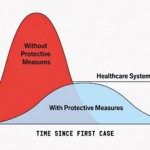Flattening the curve
View(s):You may have heard the phrase ‘flatten the curve’ in connection with the corona virus pandemic known as COVID-19, which is a shortened expression to indicate ‘Corona Virus Infectious Disease 2019’. What does this mean?
Usually with diseases, there is a period of high infections. It then reaches a peak before the rate of infections go down. If a graph is drawn with time as the horizontal axis and the number of infected people on the vertical axis, the expectation is that we obtain a bell-shaped curve, called the normal curve, where the peak is the maximum point.
However, in reality, these graphs may take on different shapes depending on the infection rate. These graphs are modelled by mathematicians with the idea of predicting the number of infections caused by the virus over time.
The essence of mathematical modelling lies in writing down a set of mathematical equations that characterize reality. These models are used to project a range of things such as number of possible patients, ICU beds, ventilators, rooms for quarantine purposes etc.
The ideal goal of a pandemic is to nullify the spread. But this is not possible until effective medication is found. Until then, slowing it down is critical to reduce the number of infections. This will give time for hospitals and governments to prepare and respond without being overwhelmed.
This is where ‘flattening the curve’ comes in. Interventions such as isolation, social distancing, disinfection, handwashing and wearing of masks, reduce the daily infections thereby flattening the curve. A flatter curve assumes the same number of people ultimately getting infected, but over a longer period of time. This means a less stressed health care system where the peak of hospitalizations is kept under the capacity line. This is the reason why countries around the world are urging social distancing and imposing lockdowns.
Dr. Tedros Adhanom Ghebreyesus, the Director General of the (WHO) World Health Organization said,
“WHO continues to call on all countries to implement a comprehensive approach, with the aim of slowing down transmission and flattening the curve. This approach is saving lives and buying time for the development of vaccines and treatments. Importantly, it buys us time for university and government scientists, and industry, to create new therapies, medications and potentially a vaccine.”
Math Plot – 45
Try to find the solution to the following puzzle. You may send solutions with reasoning to
ndesilva@osc.lk
within the next three days.
Please include your full name,
date of birth, home address,
contact details and the name of your school along with the solution.
An infection in insects is such that on the first day 2 insects are infected and on the second day double that number (4) are infected and on each successive day double the previous day’s number are infected. Altogether, how many infected insects are there after
(i) One week (ii) Two weeks?








